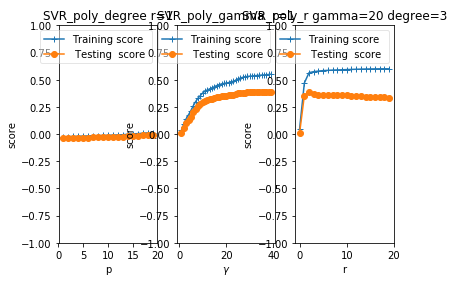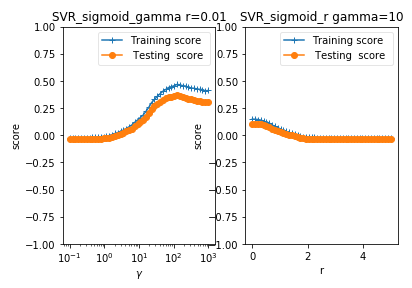吴裕雄 python 机器学习——支持向量机非线性回归SVR模型
import numpy as np
import matplotlib.pyplot as plt from sklearn import datasets, linear_model,svm
from sklearn.model_selection import train_test_split def load_data_regression():
'''
加载用于回归问题的数据集
'''
diabetes = datasets.load_diabetes() #使用 scikit-learn 自带的一个糖尿病病人的数据集
# 拆分成训练集和测试集,测试集大小为原始数据集大小的 1/4
return train_test_split(diabetes.data,diabetes.target,test_size=0.25,random_state=0) #支持向量机非线性回归SVR模型
def test_SVR_linear(*data):
X_train,X_test,y_train,y_test=data
regr=svm.SVR(kernel='linear')
regr.fit(X_train,y_train)
print('Coefficients:%s, intercept %s'%(regr.coef_,regr.intercept_))
print('Score: %.2f' % regr.score(X_test, y_test)) # 生成用于回归问题的数据集
X_train,X_test,y_train,y_test=load_data_regression()
# 调用 test_LinearSVR
test_SVR_linear(X_train,X_test,y_train,y_test)

def test_SVR_poly(*data):
'''
测试 多项式核的 SVR 的预测性能随 degree、gamma、coef0 的影响.
'''
X_train,X_test,y_train,y_test=data
fig=plt.figure()
### 测试 degree ####
degrees=range(1,20)
train_scores=[]
test_scores=[]
for degree in degrees:
regr=svm.SVR(kernel='poly',degree=degree,coef0=1)
regr.fit(X_train,y_train)
train_scores.append(regr.score(X_train,y_train))
test_scores.append(regr.score(X_test, y_test))
ax=fig.add_subplot(1,3,1)
ax.plot(degrees,train_scores,label="Training score ",marker='+' )
ax.plot(degrees,test_scores,label= " Testing score ",marker='o' )
ax.set_title( "SVR_poly_degree r=1")
ax.set_xlabel("p")
ax.set_ylabel("score")
ax.set_ylim(-1,1.)
ax.legend(loc="best",framealpha=0.5) ### 测试 gamma,固定 degree为3, coef0 为 1 ####
gammas=range(1,40)
train_scores=[]
test_scores=[]
for gamma in gammas:
regr=svm.SVR(kernel='poly',gamma=gamma,degree=3,coef0=1)
regr.fit(X_train,y_train)
train_scores.append(regr.score(X_train,y_train))
test_scores.append(regr.score(X_test, y_test))
ax=fig.add_subplot(1,3,2)
ax.plot(gammas,train_scores,label="Training score ",marker='+' )
ax.plot(gammas,test_scores,label= " Testing score ",marker='o' )
ax.set_title( "SVR_poly_gamma r=1")
ax.set_xlabel(r"$\gamma$")
ax.set_ylabel("score")
ax.set_ylim(-1,1)
ax.legend(loc="best",framealpha=0.5)
### 测试 r,固定 gamma 为 20,degree为 3 ######
rs=range(0,20)
train_scores=[]
test_scores=[]
for r in rs:
regr=svm.SVR(kernel='poly',gamma=20,degree=3,coef0=r)
regr.fit(X_train,y_train)
train_scores.append(regr.score(X_train,y_train))
test_scores.append(regr.score(X_test, y_test))
ax=fig.add_subplot(1,3,3)
ax.plot(rs,train_scores,label="Training score ",marker='+' )
ax.plot(rs,test_scores,label= " Testing score ",marker='o' )
ax.set_title( "SVR_poly_r gamma=20 degree=3")
ax.set_xlabel(r"r")
ax.set_ylabel("score")
ax.set_ylim(-1,1.)
ax.legend(loc="best",framealpha=0.5)
plt.show() # 调用 test_SVR_poly
test_SVR_poly(X_train,X_test,y_train,y_test)

def test_SVR_rbf(*data):
'''
测试 高斯核的 SVR 的预测性能随 gamma 参数的影响
'''
X_train,X_test,y_train,y_test=data
gammas=range(1,20)
train_scores=[]
test_scores=[]
for gamma in gammas:
regr=svm.SVR(kernel='rbf',gamma=gamma)
regr.fit(X_train,y_train)
train_scores.append(regr.score(X_train,y_train))
test_scores.append(regr.score(X_test, y_test))
fig=plt.figure()
ax=fig.add_subplot(1,1,1)
ax.plot(gammas,train_scores,label="Training score ",marker='+' )
ax.plot(gammas,test_scores,label= " Testing score ",marker='o' )
ax.set_title( "SVR_rbf")
ax.set_xlabel(r"$\gamma$")
ax.set_ylabel("score")
ax.set_ylim(-1,1)
ax.legend(loc="best",framealpha=0.5)
plt.show() # 调用 test_SVR_rbf
test_SVR_rbf(X_train,X_test,y_train,y_test)

def test_SVR_sigmoid(*data):
'''
测试 sigmoid 核的 SVR 的预测性能随 gamma、coef0 的影响.
'''
X_train,X_test,y_train,y_test=data
fig=plt.figure() ### 测试 gammam,固定 coef0 为 0.01 ####
gammas=np.logspace(-1,3)
train_scores=[]
test_scores=[] for gamma in gammas:
regr=svm.SVR(kernel='sigmoid',gamma=gamma,coef0=0.01)
regr.fit(X_train,y_train)
train_scores.append(regr.score(X_train,y_train))
test_scores.append(regr.score(X_test, y_test))
ax=fig.add_subplot(1,2,1)
ax.plot(gammas,train_scores,label="Training score ",marker='+' )
ax.plot(gammas,test_scores,label= " Testing score ",marker='o' )
ax.set_title( "SVR_sigmoid_gamma r=0.01")
ax.set_xscale("log")
ax.set_xlabel(r"$\gamma$")
ax.set_ylabel("score")
ax.set_ylim(-1,1)
ax.legend(loc="best",framealpha=0.5)
### 测试 r ,固定 gamma 为 10 ######
rs=np.linspace(0,5)
train_scores=[]
test_scores=[] for r in rs:
regr=svm.SVR(kernel='sigmoid',coef0=r,gamma=10)
regr.fit(X_train,y_train)
train_scores.append(regr.score(X_train,y_train))
test_scores.append(regr.score(X_test, y_test))
ax=fig.add_subplot(1,2,2)
ax.plot(rs,train_scores,label="Training score ",marker='+' )
ax.plot(rs,test_scores,label= " Testing score ",marker='o' )
ax.set_title( "SVR_sigmoid_r gamma=10")
ax.set_xlabel(r"r")
ax.set_ylabel("score")
ax.set_ylim(-1,1)
ax.legend(loc="best",framealpha=0.5)
plt.show() # 调用 test_SVR_sigmoid
test_SVR_sigmoid(X_train,X_test,y_train,y_test)

吴裕雄 python 机器学习——支持向量机非线性回归SVR模型的更多相关文章
- 吴裕雄 python 机器学习——支持向量机线性回归SVR模型
import numpy as np import matplotlib.pyplot as plt from sklearn import datasets, linear_model,svm fr ...
- 吴裕雄 python 机器学习——支持向量机SVM非线性分类SVC模型
import numpy as np import matplotlib.pyplot as plt from sklearn import datasets, linear_model,svm fr ...
- 吴裕雄 python 机器学习——支持向量机线性分类LinearSVC模型
import numpy as np import matplotlib.pyplot as plt from sklearn import datasets, linear_model,svm fr ...
- 吴裕雄 python 机器学习——层次聚类AgglomerativeClustering模型
import numpy as np import matplotlib.pyplot as plt from sklearn import cluster from sklearn.metrics ...
- 吴裕雄 python 机器学习——密度聚类DBSCAN模型
import numpy as np import matplotlib.pyplot as plt from sklearn import cluster from sklearn.metrics ...
- 吴裕雄 python 机器学习——KNN回归KNeighborsRegressor模型
import numpy as np import matplotlib.pyplot as plt from sklearn import neighbors, datasets from skle ...
- 吴裕雄 python 机器学习——KNN分类KNeighborsClassifier模型
import numpy as np import matplotlib.pyplot as plt from sklearn import neighbors, datasets from skle ...
- 吴裕雄 python 机器学习——半监督学习LabelSpreading模型
import numpy as np import matplotlib.pyplot as plt from sklearn import metrics from sklearn import d ...
- 吴裕雄 python 机器学习——分类决策树模型
import numpy as np import matplotlib.pyplot as plt from sklearn import datasets from sklearn.model_s ...
随机推荐
- 问题:modbus_tk开发中遇到[Errno 98] Address already in use (已解决)
案例: from modbus_tk import modbus_tcp,defines import time s = modbus_tcp.TcpServer(port=5300) def mai ...
- B树与B+
简单剖析B树(B-Tree)与B+树https://blog.csdn.net/z_ryan/article/details/79685072 B树和B+树的插入.删除图文详解https://www. ...
- 13-----BBS论坛
BBS论坛(十三) 13.1点击更换图形验证码 (1)front/signup.html <div class="form-group"> <div class= ...
- 转 JDBC连接数据库(二)——连接池
https://www.cnblogs.com/xiaotiaosi/p/6398371.html 数据库保持长连接,不过一直都是idle,除非有用户激活连接,这样后果是无法删除用户,但是不影响数据库 ...
- OS---存储器
1.存储器的层次结构 1.1 概述 理想情况下,存储器应当速度非常快.并且与处理器的速度匹配.容量大且价格低廉: 实际情况,无法满足上述三个条件: 于是在现在OS中,存储器采用 层次结构 来组织: ...
- python_文件的打开和关闭
文件对象 = open('文件名','使用方式')rt:读取一个txt文件wt: 只写打开一个txt文件,(如果没有该文件则新建该文件)会覆盖原有内容at:打开一个txt文件,并从文件指针位置追加写内 ...
- vue-cli构建项目在index.html中使用静态文件
在vue-cli构建的项目中,且使用在移动端,我们希望每一个页面加载时都可以使用flexible.js来适配手机. 那么这个flexible.js被import到每一个组件中就不合适了. 好的方法是直 ...
- idea安装激活
安装激活链接: https://blog.csdn.net/newabcc/article/details/80601933 激活出错链接:(key is invalid 失效) https://bl ...
- vue学习第三天 ------ 临时笔记
说明:之前两天属于入门,文章可能存在片段信息 vue2.x+webpack快速搭建前端项目框架详解 http://www.jb51.net/article/129463.htmVue cli + We ...
- BZOJ1563: [NOI2009]诗人小G(决策单调性 前缀和 dp)
题意 题目链接 Sol 很显然的一个dp方程 \(f_i = min(f_j + (sum_i - sum_j - 1 - L)^P)\) 其中\(sum_i = \sum_{j = 1}^i len ...
